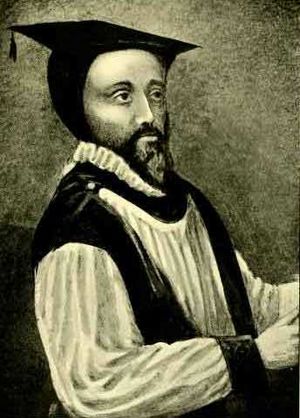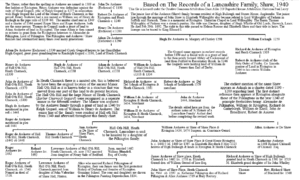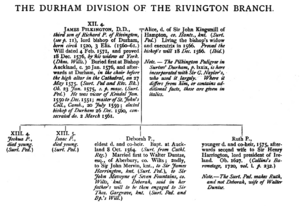James Pilkington (bishop) facts for kids
Quick facts for kids The Right Reverend James Pilkington B.D. |
|
|---|---|
| Bishop of Durham | |
 |
|
| Province | York |
| Diocese | Durham |
| Enthroned | 10 April 1561 |
| Reign ended | 23 January 1576 |
| Predecessor | Cuthbert Tunstall |
| Successor | Richard Barnes |
| Other posts | Regius Professor of Divinity at Cambridge and Master of St John's College, Cambridge |
| Orders | |
| Consecration | 2 March 1561 |
| Personal details | |
| Born | 1520 Rivington, Lancashire, England |
| Died | 23 January 1576 (aged 55) Bishop Auckland, County Durham, England |
| Buried | Durham Cathedral |
| Nationality | English |
| Denomination | Church of England |
| Parents | Richard Pilkington Alice Asshaw |
| Spouse | Alice Kingsmill |
| Children | 4 |
| Occupation | Bishop of Durham and Author |
| Alma mater | Pembroke College, Cambridge St John's College, Cambridge |
James Pilkington (1520–1576) was an important English leader. He was the first Protestant Bishop of Durham from 1561 until he passed away in 1576. He also started Rivington Grammar School. James Pilkington was a well-known writer and speaker during the time of Queen Elizabeth I.
Contents
Early Life and Education
James Pilkington was born in 1520 in Rivington, Lancashire, England. He was the second son of Richard Pilkington and Alice Asshaw. His family had owned land in Rivington since 1212.
James likely went to Manchester Grammar School for his early education. In 1536, he started studying at Pembroke College, Cambridge. Later, he moved to St John's College, Cambridge. He earned his first degree in 1539 and a master's degree in 1542.
In 1545, James Pilkington became the Vicar of Kendal. But he soon left this job to go back to Cambridge. By 1550, he was the president of St John's College. He earned another degree in theology in 1551.
Family Life
Around 1564, James Pilkington married Alice Kingsmill. Alice was the daughter of Sir John Kingsmill, a well-known Protestant leader. They had two sons and two daughters.
Sadly, their sons, Joshua and Isaac, died when they were very young. Their daughter Deborah married twice. Their younger daughter, Ruth, married Sir Henry Harrington in 1587.
Time in Exile
When King Edward VI died in 1553, his sister Mary I became Queen. Queen Mary was a Roman Catholic. She wanted England to return to the Catholic Church.
During her rule, many Protestants were arrested and even killed. To stay safe, James Pilkington left England. He traveled to cities in Europe like Zürich, Geneva, and Frankfurt. While there, he taught Protestant children. He also met with other Protestant leaders. He helped gather support for Princess Elizabeth.
When Queen Mary died in 1558, Queen Elizabeth I became ruler. James Pilkington returned to England in 1559.
A Powerful Speaker
After returning to England, James Pilkington became a famous preacher. He gave important speeches in London. On July 20, 1559, he was made Master of St John's College. He also became a professor of divinity at Cambridge.
In June 1560, he gave a sermon to Queen Elizabeth I. The Queen was very impressed by his speech. She encouraged the study of divinity at universities. In 1560, he wrote a detailed book about the prophet Haggai from the Bible.
Becoming a Bishop
James Pilkington was offered the job of Bishop of Winchester. But he turned it down because of a disagreement. He did not agree with the Crown taking land from the church.
However, he was later chosen to be the Bishop of Durham. He became bishop on March 2, 1561. He officially started his role on April 10. He worked hard to get church lands back for his diocese.
In June 1561, St Paul's Cathedral was badly damaged by lightning. James Pilkington gave a sermon. He said the damage was a sign of God's anger. This made some people angry. A Catholic writer said it happened because England left the old faith. Pilkington wrote a strong reply defending the Protestant church.
As bishop, Pilkington tried to bring order to his area. He dealt with people who refused to follow the Church of England. He also worked with others to make sure strong Protestant leaders were appointed. Many of these new leaders were his own family and friends. In 1565, he helped give the citizens of Durham a special charter.
Promoting Education
One of Bishop Pilkington's biggest contributions was his support for education. He was very keen on it. When he arrived in Durham in 1561, he thought about starting a school in his home. In 1567, he asked the Queen to help start a Free Grammar School in Darlington.
His most important achievement was starting Rivington Free Grammar School in 1566. This school was near Rivington Church. In his will, he left books to the school, his family, and friends.
A stained glass window at Rivington and Blackrod High School Chapel honors the bishop. It shows parts of his life. These include his time at St John's College and his exile in Europe. It also shows him teaching children in Zürich.
The Rising of the North
In 1569, there was a big rebellion called the Rising of the North. It was led by two powerful noblemen. They wanted to overthrow Queen Elizabeth I. They also wanted to bring back the Roman Catholic religion.
Bishop Pilkington and his family had to flee to London. They dressed as beggars to escape. The rebels entered Durham, the bishop's city, on November 14. They destroyed English Bibles and prayer books. They held a Catholic Mass in Durham Cathedral. They said they wanted to bring back Catholicism.
The rebellion had a lot of support in the area. But it eventually failed. Many rebels were punished. The bishop was not allowed to gain from the lands taken from the rebels.
Death and Legacy
James Pilkington died on January 23, 1576, in Bishop Auckland. He was 55 years old. He was first buried in Bishop Auckland. Later, his body was moved to Durham Cathedral.
He made sure his daughters were well provided for when they married. He also helped his four brothers get important jobs in his diocese.
Before he became bishop, he helped create the Book of Common Prayer in 1559. He also worked on the Thirty-Nine Articles, which are key beliefs of the Church of England. He wrote commentaries on parts of the Bible. His last book was published after his death in 1585. A collection of his writings was published in 1842.
The Pilkington Painting
The "Pilkington Painting" is found in Rivington Church in Lancashire. Bishop Pilkington ordered this painting in 1566. It was made to remember his father, who built the church. The original painting was damaged in a fire in 1834. A copy made in 1821 was then copied again in 1835. This 1835 copy is what you see in the church today.
The painting shows columns that look like Durham Cathedral. It also shows family shields. One shield is for the Pilkington family. Another shows the bishop's special shield as Bishop of Durham. A third shield is for his wife, Alice Kingsmill.
At the bottom left of the painting, you can see Richard Pilkington and his seven sons. Across the table are Alice and her five daughters. Bishop James Pilkington is shown wearing his bishop's robes.
At the top of the painting, there is a Latin phrase: 'VTVIT POST FUNERA VIRTUS'. This means 'Virtue lives after death'. There are also messages written on the painting. They tell about Richard Pilkington building the church. They mention Alice Asshawe having 12 children, three of whom became preachers. They also state that James became Bishop of Durham in 1560. It also says he opened the school in 1566.





